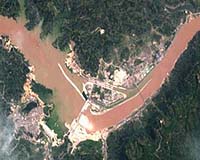| . |  |
. |
Beijing (UPI) Nov 3, 2009 As the water level in the reservoir on the Yangtze River approaches its final height of 175 meters, criticism of China's Three Gorges Dam continues. The completion of Three Gorges is being met with little fanfare, unlike the elaborate celebrations Beijing staged 12 years ago to mark the diversion of the Yangtze on the spot of the future massive dam, Inter Press Service reports. In China, critics are saying filling of the dam is worsening the drought already affecting the Yangtze's delta. And Chinese diplomats are being met with skepticism in their efforts to promote hydropower across Asia and Africa. To construct Three Gorges -- the world's largest and most expensive dam -- 1,350 villages were submerged and 1.3 million displaced from their homes. The dam has a capacity of 18,000 megawatts of electricity. The dam's original cost, when approved in 1992, was estimated at $8.3 billion. That figure has now risen to $27 billion by Beijing's estimate, while other predictions slate the final cost at $88 billion. "The Three Gorges dam is a model of the past," said Peter Bosshard, the policy director of California-based International Rivers, an organization whose mission is "to protect rivers and the communities that depend on them," Inter Press reports. "There are smarter ways of generating energy and managing floods than by building outdated mega-projects," said Bosshard. By blocking the flow of the Yangtze, its ecosystem has been altered to the extent that rare river species of dolphin and sturgeon are now facing extinction. Commercial fisheries along the Yangtze as well as off the river's mouth in the East China Sea have declined. And landslides, pollution of freshwater supplies and a greater risk of earthquakes are among the side effects of the dam. In September 2007 government officials admitted, "If preventive measures are not taken, there could be an environmental collapse." Pan Jiazheng, hydrologist with the Chinese Academy of Engineering, maintains that water is the only renewable energy source in China that can be developed on a large scale. "Developing hydropower is the only viable way to make a dent in China's consumption of coal," Pan told Inter Press. "Those who argue that hydropower is not a clean energy have to ask themselves whether there is any other task more urgent for China's clean development than burning less coal." Despite domestic and foreign criticism of Three Gorges, China is actively seeking to build hydropower projects in countries ranging from Cambodia to Pakistan to Nigeria. "It is quasi-science to believe that hydropower equals green energy," said Zheng Yisheng, who researches environment and development at the Chinese Academy of Social Sciences. "You can't see rivers just as a source of energy and choose to ignore their ecological function as ecosystems. People need energy but they need a place to live, too."
Share This Article With Planet Earth
Related Links Water News - Science, Technology and Politics
 1.27 million displaced by China's Three Gorges Dam: report
1.27 million displaced by China's Three Gorges Dam: reportBeijing (AFP) Sept 13, 2009 China has relocated 1.27 million people to make way for the controversial Three Gorges dam development, the world's largest hydroelectric project, state media reported. The figure was the total number of relocations as of the end of June, a top dam construction official was quoted as saying by Xinhua news agency in a report issued late Saturday. Chinese officials have previously said ... read more |
|
| The content herein, unless otherwise known to be public domain, are Copyright 1995-2009 - SpaceDaily. AFP and UPI Wire Stories are copyright Agence France-Presse and United Press International. ESA Portal Reports are copyright European Space Agency. All NASA sourced material is public domain. Additional copyrights may apply in whole or part to other bona fide parties. Advertising does not imply endorsement,agreement or approval of any opinions, statements or information provided by SpaceDaily on any Web page published or hosted by SpaceDaily. Privacy Statement |